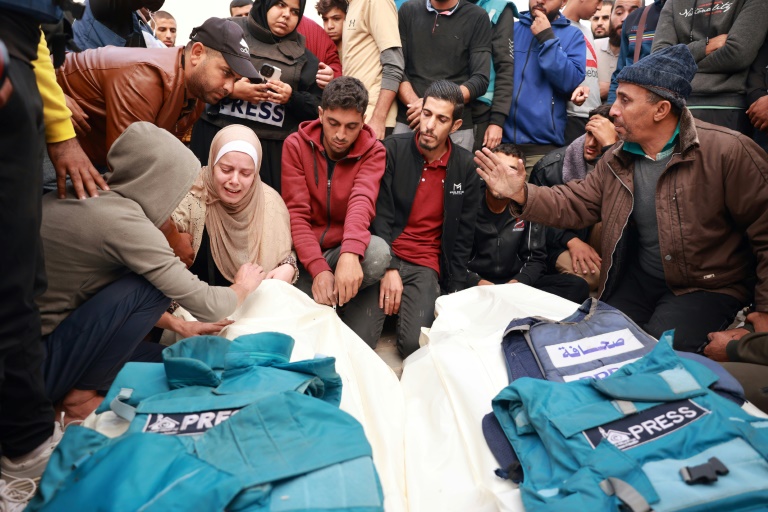Gaza journalists both witnesses and victims of war

Relatives and colleagues of two Palestinian journalists, Hasouna Slim and Sari Mansoor, killed in an Israeli strike, mourn over their bodies during their funeral in Deir al-Balah in the southern Gaza Strip on November 19
Jerusalem – Journalists in the Gaza Strip are paying a heavy price to cover the war between Israel and Hamas, with scores already killed and injured.
Those surviving face constant danger from the relentless Israeli bombardment of the Palestinian territory, as well as grappling with communications difficulties, concern for their families and shortages of basic goods.
“Our work is to document the war, to let the world know what is happening,” Gazan journalist Hind Khoudary told AFP.
But they know it comes at a cost. On Friday, Al Jazeera cameraman Samer Abu Daqqa became the latest fatality — killed while reporting in southern Gaza.
More journalists have been killed in the Gaza war over such a short period than in any other conflict in at least 30 years, said media watchdog Reporters Without Borders (RSF).
According to the Committee to Protect Journalists, at least 64 media professionals — including journalists, photographers, cameramen, technicians and drivers — have been killed, most in Gaza, since Hamas militants stormed across the border into Israel on October 7.
Each day is “a question of life or death,” said Palestinian photojournalist Motaz Azaiza.
Some have died in bombardments, at home with their families. Others have died while practising their profession.
Three journalists were killed in Lebanon amid hostilities with Hezbollah along Israel’s northern border, and four Israeli media workers were killed during the Hamas attack on their kibbutz.
According to an AFP tally based on the latest official Israeli figures, some 1,140 people were killed in southern Israel that day, and around 250 taken hostage and dragged back to Gaza.
Vowing to wipe out Hamas, Israel has kept up a relentess bombardment of Gaza which has so far killed more than 19,400 people, according to the Hamas-run health ministry.
– Forced to flee –
Like some 1.9 million Gazans, Khoudary has had to flee south, leaving behind her office and her home — “a piece of my heart”, she said.
She set out first for the Al-Shifa hospital, where thousands sought refuge, then trekked to Rafah on the closed southern border with Egypt. But she has never stopped documenting “the horrors” of the war.
What is happening in Gaza is “the suffocation of journalism,” said Jonathan Dagher, head of RSF for the Middle East.
Even before the war erupted, journalists had a tough time in Gaza under the rule of Hamas, which gained control of the territory in 2007.
“Under Hamas, doing journalism has changed significantly from the situation under the Palestinian Authority” which is less restrictive, said Adel Zaanoun, a journalist with AFP for nearly 30 years.
“Hamas usually doesn’t object to coverage of Israeli military operations, but completely banned any coverage of its own military activities, including of military posts, weapons and tunnels.”
The group, considered a terrorist organisation by the United States, the European Union and Israel, “has also banned any coverage of corruption in their government”, and its “security forces do not condone any criticism on social media”.
Since the fighting began, Rami Abu Jamus, a journalist and fixer for numerous French outlets, has been documenting life in Gaza — “a duty” he calls it.
– Losing loved ones –
In between videos of bodies and pleas from the wounded, there are others when he plays with his daughter coaxing a smile from her.
Followed by more than 17 million people, photojournalist Azaiza also captures in his pictures and livestreams the distress of the displaced, as well as his own “despair”.
Both witness and participant, he has also pulled bodies from the rubble or transported injured children to hospital.
All of the journalists AFP interviewed — including two working with the agency — have buried a loved one, relative or friend since the start of the war.
Sometimes tragedy strikes at work. While live on camera, Al Jazeera’s Gaza bureau chief Wael al-Dahdouh learned of the death of his wife and two children in an Israeli strike.
“My greatest fear was never doing my job, but rather losing my loved ones,” he told AFP.
On Friday, Dahdouh was also wounded in the arm during the same strike that killed camerman Abu Daqqa.
During the war Palestinian journalists “have experienced a life of displacement, homelessness, and forced relocation,” Dahdouh added.
– ‘Open the doors’ –
Since the war began, RSF has decried the “inability of Israel to protect the reporters on the ground, who have no safe refuge”.
And while everyone in Gaza is suffering from a lack of fuel, food and water, journalists are in desperate need of electricity to charge phones, cameras and computers.
The grid is often down, and communications frequently cut.
“In cutting off the internet, the Israeli authorities are preventing journalists from working. It’s a blow to the right to information,” said RSF’s Dagher.
Journalists have had to resort to ingenious methods to keep working – filing from rooftops to capture a signal amid frequent telecommunications blackouts.
RSF has urged authorities to “open the doors” of the Rafah border crossing, controlled by Egypt, so “journalists can finally come and go on either side of the border”.
After 73 days of war, AFP’s Zaanoun is exhausted. His only wish is to “get my family to safety”.
